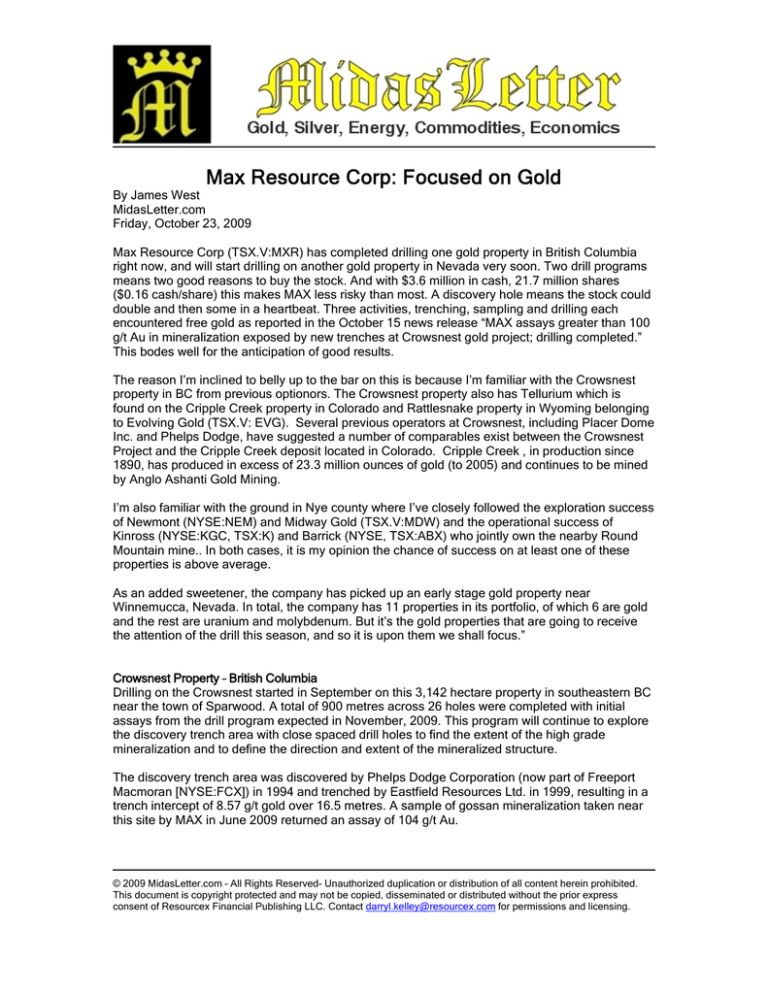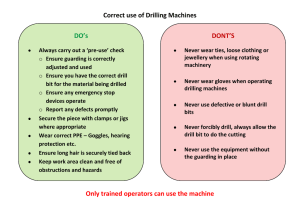
Max Resource Corp: Focused on Gold
By James West
MidasLetter.com
Friday, October 23, 2009
Max Resource Corp (TSX.V:MXR) has completed drilling one gold property in British Columbia
right now, and will start drilling on another gold property in Nevada very soon. Two drill programs
means two good reasons to buy the stock. And with $3.6 million in cash, 21.7 million shares
($0.16 cash/share) this makes MAX less risky than most. A discovery hole means the stock could
double and then some in a heartbeat. Three activities, trenching, sampling and drilling each
encountered free gold as reported in the October 15 news release “MAX assays greater than 100
g/t Au in mineralization exposed by new trenches at Crowsnest gold project; drilling completed.”
This bodes well for the anticipation of good results.
The reason I’m inclined to belly up to the bar on this is because I’m familiar with the Crowsnest
property in BC from previous optionors. The Crowsnest property also has Tellurium which is
found on the Cripple Creek property in Colorado and Rattlesnake property in Wyoming belonging
to Evolving Gold (TSX.V: EVG). Several previous operators at Crowsnest, including Placer Dome
Inc. and Phelps Dodge, have suggested a number of comparables exist between the Crowsnest
Project and the Cripple Creek deposit located in Colorado. Cripple Creek , in production since
1890, has produced in excess of 23.3 million ounces of gold (to 2005) and continues to be mined
by Anglo Ashanti Gold Mining.
I’m also familiar with the ground in Nye county where I’ve closely followed the exploration success
of Newmont (NYSE:NEM) and Midway Gold (TSX.V:MDW) and the operational success of
Kinross (NYSE:KGC, TSX:K) and Barrick (NYSE, TSX:ABX) who jointly own the nearby Round
Mountain mine.. In both cases, it is my opinion the chance of success on at least one of these
properties is above average.
As an added sweetener, the company has picked up an early stage gold property near
Winnemucca, Nevada. In total, the company has 11 properties in its portfolio, of which 6 are gold
and the rest are uranium and molybdenum. But it’s the gold properties that are going to receive
the attention of the drill this season, and so it is upon them we shall focus.”
Crowsnest Property – British Columbia
Drilling on the Crowsnest started in September on this 3,142 hectare property in southeastern BC
near the town of Sparwood. A total of 900 metres across 26 holes were completed with initial
assays from the drill program expected in November, 2009. This program will continue to explore
the discovery trench area with close spaced drill holes to find the extent of the high grade
mineralization and to define the direction and extent of the mineralized structure.
The discovery trench area was discovered by Phelps Dodge Corporation (now part of Freeport
Macmoran [NYSE:FCX]) in 1994 and trenched by Eastfield Resources Ltd. in 1999, resulting in a
trench intercept of 8.57 g/t gold over 16.5 metres. A sample of gossan mineralization taken near
this site by MAX in June 2009 returned an assay of 104 g/t Au.
© 2009 MidasLetter.com – All Rights Reserved- Unauthorized duplication or distribution of all content herein prohibited.
This document is copyright protected and may not be copied, disseminated or distributed without the prior express
consent of Resourcex Financial Publishing LLC. Contact darryl.kelley@resourcex.com for permissions and licensing.
Crowsnest Property, southeastern British Columbia
Several previous operators at Crowsnest, including Placer Dome Inc. and Phelps Dodge, have
suggested a number of comparables exist between the Crowsnest Project and the Cripple Creek
deposit located in Colorado. These comparables include the tectonic setting, alkalic intrusive
association and occurrence of tellurium. Cripple Creek, in production since 1890, has produced in
excess of 23.3 million ounces of gold (to 2005) and continues to be mined by Anglo Ashanti Gold
Mining (NYSE:AU).
Besides drilling, exploration at Crowsnest will also include following up on previously reported
float samples that contained values up to 524 grams per tonne gold, and re-examination of a
sample grid further to the west where reported gold values ran as high as 30,000 ppb Au. Many
other areas contain significant gold values that have never been followed up on and will be
examined as time permits.
One bedrock source of mineralization was discovered in 1996 and trenched by Eastfield in 1999,
resulting in a trench intercept of 8.57 g/t gold over 16.5 metres. The 1999 area of focus,
referred to as the Discovery Trench Area (see picture below), has been the centre of most of the
exploration activity completed at Crowsnest during exploration conducted in 1999, 2002, 2003
and 2006. The most recent exploration at Crowsnest in 2006 entailed road reconstruction and
mechanical trenching, again largely in the Discovery Trench Area. Other areas that have also
yielded high grade float samples have had only rudimentary work completed. A review of the
database calculates an average gold grade for samples of this float exceeding 1.0 g/t to be
32.656 g/t (based on 36 determinations) with a corresponding copper grade of 0.23% (based on
34 determinations).
© 2009 MidasLetter.com – All Rights Reserved- Unauthorized duplication or distribution of all content herein prohibited.
This document is copyright protected and may not be copied, disseminated or distributed without the prior express
consent of Resourcex Financial Publishing LLC. Contact darryl.kelley@resourcex.com for permissions and licensing.
Mr. Clancy Wendt, VP Exploration for MAX said, “We are pleased with our initial exploration
results at Crowsnest and look forward to the assay results in November. During drilling, small
amounts of each drill sample were panned to identify free gold; this helped us to identify where
gold exists in the mineralized system. While drilling was underway, other areas on the property
were re-examined where prior operators had reported float samples up to 524 g/t gold. Several
samples were taken and have been submitted for assay. Finding visible gold in the new trenches
as well as in additional samples taken this year is providing us with a better understanding of the
quality of the mineralized system at Crowsnest and its potential overall extent. This will greatly
assist future exploration on the project.”
East Manhattan Wash Project – Nye County, Nevada
More than 1,000,000 ounces of gold
have been mined in the Manhattan
mining district. Production has
included the nearby Manhattan
mine (1974-1990), an open-pit
operation that produced 236,000
ounces of gold at an average grade
of 0.08 ounce per ton ("opt"). The
Echo Bay East and West Pit
deposits operated in the early
1990s, producing 260,000 ounces
at an average grade of 0.06 opt.
The Round Mountain Mine
(Kinross/Barrick), situated eight
miles north of EMW, is a
conventional open pit operation that
has produced more than 12 million
ounces of gold to date. Recorded
placer gold production from the
district totals approximately 150,000
ounces from a major dredge
operation and small-scale lode
mines have produced another
100,000 ounces.
Clancy Wendt, Vice-President
Exploration for MAX, states that
"We are pleased with finding native
gold over a very large area. The two
areas sampled, the Old Drill Hole
and Gold Pit zones, are significantly
larger than originally thought and are still open in at least three directions. In addition, they are
only 500 feet apart and may be connected. Further sampling will be undertaken to test this
theory."
© 2009 MidasLetter.com – All Rights Reserved- Unauthorized duplication or distribution of all content herein prohibited.
This document is copyright protected and may not be copied, disseminated or distributed without the prior express
consent of Resourcex Financial Publishing LLC. Contact darryl.kelley@resourcex.com for permissions and licensing.
Bulk sampling from a summer 2009 program yielded 4.9 grams/ton gold and 1.2 grams/ton silver
from a 793 pound sample.
Table Top Mountain – Humboldt County, Nevada
Numerous mines have been prolific producers of gold since the beginning of gold exploration in
Nevada in the late 1800’s. Most recently, the Pinson Mine produced over 987,000 ounces of gold
from relatively low-grade oxidized ore by open pit mining methods, prior to 2000. Gold production
came from decalcified, locally silicified and/or argillized, fine-grained, limy sedimentary rocks of
the Ordovician Comus Formation. Mineralization is focused along and adjacent to the Getchell
Fault zone.
On March 26, 1986 AMAX poured its first gold bar from the Sleeper Canyon Gold mine three
months ahead of schedule and little more than a year after the discovery had been announced.
Although the mine plan called for production of about 40,000 ounces in 1986, the mine actually
produced 126,000 ounces of gold during the year at an average cost of less than $60 per ounce,
making it one of the lowest cost gold mines in the world at the time.
In September 1986, AMAX began processing low-grade material in a heap leach circuit.
Production increased to 159,000 ounces in 1987 (the first full year of production) and to 230,000
ounces in 1988 at an average cost of $103 per ounce. AMAX produced a total of 2.5 million
ounces of gold from the Sleeper deposit.
The Table Top area is on trend with the Sleeper Canyon Mine (2.5 MM oz Au produced), located
25 miles to the north, and is geologically favourable for the discovery of a medium-sized high
grade, bonanza style gold deposit in a near surface environment.
During the 1980's Gold Fields, Meridian Minerals and Santa Fe Mining conducted exploration on
and around the Table Top property. A limited exploration program of only ten reverse circulation
drill holes was conducted to test anomalous, up to 100,000 ppb, gold values in jasperoid.
Trenches containing gold values up to 4 grams over 5 meters were tested by the first drill hole,
which contained 55 feet of 0.027 opt Au from the surface down. This hole was drilled vertically in
a breccia zone. The remaining nine drill holes contained little of significance except around the
original drill hole. A follow up analysis showed that the exploration was centered in the wrong
direction and that the holes should have been drilled to the south instead of to the north. MAX
intends to test this theory during drilling to be conducted in November 2009.
With Max Resource Corp drilling completed now on the Crowsnest, and with results expected in
November, it might be a good time to take a closer look at the company. Drilling will soon begin
on the Table Top property in Nevada, with more exploration to follow on the East Manhattan
Wash.
Follow Max Resource Corp.’s progress at http://www.maxresource.com.
© 2009 MidasLetter.com – All Rights Reserved- Unauthorized duplication or distribution of all content herein prohibited.
This document is copyright protected and may not be copied, disseminated or distributed without the prior express
consent of Resourcex Financial Publishing LLC. Contact darryl.kelley@resourcex.com for permissions and licensing.




